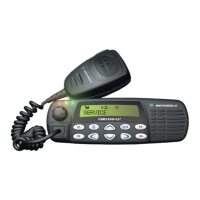2-6 Theory
of
Operation
The option board interfaces are different in that the
1-1P
can also read data back from devices
connected.The timing and operation
of
this interface is specific to the option connected, but the
general pattern is as follows:
Option
board generates a service request via J0551, pin 29, line
ROY,
and
IJP,
pin 79
The main board asserts a chip
select for that option board via U0141 ,pin 14, line OPT CS,
J0551
,pin 30
The main board
1-1P
generates the CLK (J0551 , pin
3)
The main board
1-1P
writes serial data via J0551 , pin
15
and reads serial data via J0551, pin
16
When data transfer is complete the main board terminates the chip select and CLK activity
2.2.8
SBEP
Serial Interface
The SBEP serial interface allows the radio
to
communicate with the Customer Programming
Software (CPS), or the
universal tuner via the Radio Interface Box (RIB). This interface connects to
the microphone connector via
control head connector (J0401, pin
8)
or
to the accessory connector
J0401, pin 17 and comprises BUS+. The line
is
bi-directional, meaning that either the radio or the
RIB can drive the line. The
1-1P
sends serial data via pin 98 and 00101 and it reads serial data via pin
97. Whenever the
1-1
P detects activity on the BUS+ line, it starts communication.
In
addition, the SBEP serial interface is used to communicate with a connected control head. When
a
control head key is pressed or the volume knob is rotated, the line ON OFF CONTROL goes high.
This turns on transistor
00110
which pulls line ON OFF SENSE and
1-JP,
pin 6 to ground level.
In
addition, an interrupt
is
generated via
R01
09 (for SELECT 5 I MDC models) and
IJP,
pin 96. This
indicates that the
control head wants
to
start SBEP communication. The
1-1P
then reads the registers
of
the Universal Asynchronous Receiver Transmitter (UART) U0125
to
determine that the interrupt
source was the
control head.
If
the interrupt source was from the control head, the
1-1P
requests the
data from the
control head. The control head starts sending and after all data has been sent, the ON
OFF CONTROL line
goes low.
The
control head ignores any data on BUS+ during SBEP
communication with the
CPS or universal tuner.
2.2.9 General Purpose Input/Output
The controller provides eight general purpose lines (DIG1 through DIGS) available on the accessory
connector
J0501
to
interface
the
external options. Lines DIG IN 1 ,3,5,6, are inputs, DIG OUT 2 is an
output and
DIG
IN
OUT
4,7
,8
are bidirectional. The software and the hardware
of
the radio model
define the function
of
each port.
DIG
IN
1 can be used as external PTT input or others, set by the CPS. The
1-1P
reads this port via pin
77 and
00171
.
DIG OUT
2 can be used as normal output or external alarm output, set by the CPS. Transistor
00173
is controlled by the
1-1P
via ASFIC
CMP,
pin 14.
DIG IN 3 is read by
IJP,
pin 63 via resistor R0176
DIG
IN
5 can be used as normal input or emergency input, set by the CPS. The
1-1P
reads this port
via
R0179 and
1-JP,
pin 60. Diode D01791imits the voltage to protect the
1-1P
input.
DIG
IN
6 can be used as normal input, set by the CPS. The
1-1P
reads this port via, pin 74 and
00181.
DIG IN
OUT
4,7,8 are bidirectional and use
the
same circuit configuration. Each port uses an output
transistor
00177,00183,00185
controlled by
JJP,
pins46,
47, 53. The ports are read by
IJP,
pins 75,
54, 76.
To
use one
of
the ports as input the
1-1P
must turn off the corresponding output transistor.
In
addition the signals from DIG IN
1,
DIG IN OUT 4 are fed to the option board connector J0551
and the expansion board connector J0451.

